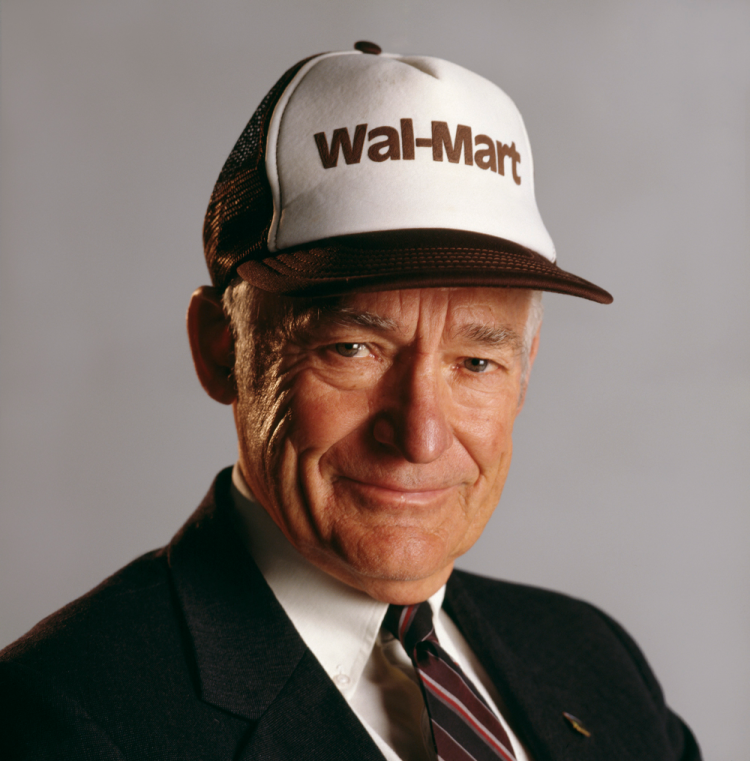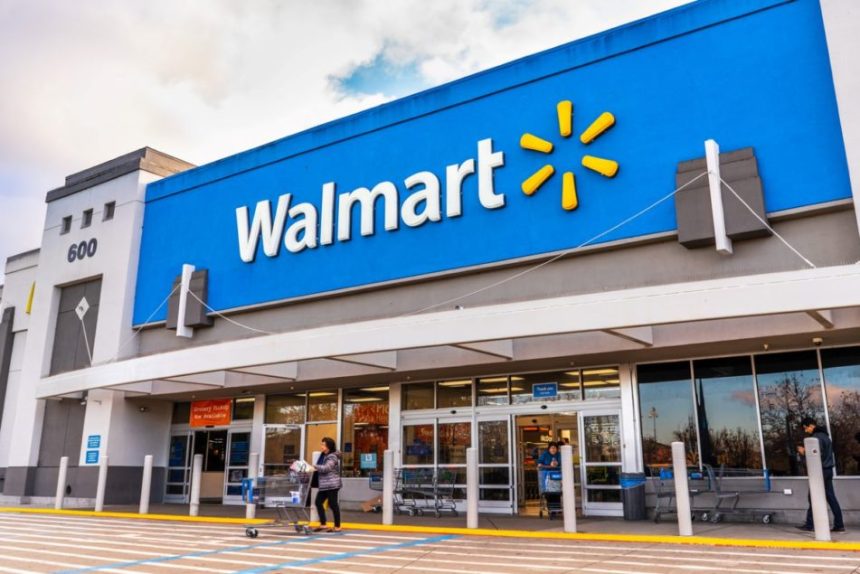Walmart Inc. (WMT), headquartered in Bentonville, Arkansas, is a major American multinational and a global leader in retail industry. Walmart operates more than 10,500 stores and numerous eCommerce websites in 19 countries. Starting in the five-and-dime store sector, Walmart grew into the global retail giant it is today by evolving and enhancing the strategies and principles that shaped its industry.
History Of Walmart
Walmart’s history began in 1962 when Sam Walton opened the first Walmart in Rogers, Arkansas, with a vision to offer low prices to help people save money and live better.

Sam Walton’s goal was to sell products at low prices to boost sales, even if it meant making less profit on each item, all while benefiting the consumer. He faced challenges due to unusually high costs for leases and purchasing branches. However, he managed to find suppliers that offered cheaper prices than those used by other stores, allowing him to lower his prices and beat his competitors.
“If we work together, we’ll lower the cost of living for everyone…we’ll give the world an opportunity to seewhat it’s like to save and have a better life.” – Sam Walton, Founder of Walmart
By 1967, Walmart had expanded to 24 stores, and it went public in 1970. Through the decades, it became a retail giant, diversifying internationally and online, always focused on innovation and serving communities. Today, Walmart remains a leader in retail, with a global presence and an emphasis on e-commerce and environmental sustainability.
The company sustained unprecedented levels of growth throughout the 1990s, entering the new millennium with over a million employees at nearly 4,000 locations across the globe. After Walton’s death, his eldest son and heir to the family fortune, Rob, became the chairman of Walmart’s board, a position he held until 2015.
Walmart’s Business Model

Walmart’s core strategy is centered on its “Everyday Low Price” (EDLP) approach, aiming to provide customers with one-stop shopping convenience. The company offers a wide range of products, from groceries to entertainment, available through stores, mobile apps, and Walmart.com. In the U.S., Walmart operates three distinct store formats, each tailored to meet the specific needs of its neighborhood. This strategy enhances customer experience by delivering variety, convenience, and low pricing.
Walmart’s distribution network is one of the largest globally, with 210 centers that service stores, clubs, and direct deliveries to customers. The fleet consists of 9,000 tractors, 80,000 trailers, and over 11,000 drivers. Each distribution center, covering more than 1 million square feet, handles over 200 trailers daily and supports 90 to 100 stores within a 150+ mile radius. Walmart also has six disaster distribution centers across the country, ensuring quick response to communities affected by natural disasters.
Walmart Ownership
Walmart Inc. is a joint-stock company based in Delaware and registered with the U.S. Securities and Exchange Commission. Its official office is located at Wolters Kluwer’s Corporation Trust Center in Wilmington. As of March 2017, Walmart has 3,292,377,090 outstanding shares. These shares are primarily held by the Walton family, along with several institutional investors and funds.
Here’s the ownership chart of Walmart Inc.;
Financial Position Of Walmart
According to the Fortune Global 500 list in October 2022, Walmart ranks as the world’s largest company by revenue. In February 2023, Walmart reported total revenue of $611.3 billion for its Fiscal Year 2023.
For the fiscal year ending on January 31, 2019, Walmart reported a net income of $6.6 billion on total revenue of $514 billion. Of that, $120 billion, or 23.7%, came from international operations. According to the Forbes Global 2000 list, Walmart ranked as the 23rd-largest public corporation in the world and held the title of the largest public corporation by revenue.
As of 2024, Walmart has a net worth or market cap of $685.50 billion. Its market cap has increased by 55.86% in one year. Walmart’s stock price is trading at around $85.28 per unit share.
Here’s the table of Walmart’s performance and revenue for the past 5 years;
| Year | Revenue (US$ millions) | Net Income (US$ billions) | Total Assets (US$ billions) | Employees | Stores |
|---|---|---|---|---|---|
| 2019 | 514,000 | 6.6 | 219 | 2,200,000 | 11,361 |
| 2020 | 523,000 | 14.8 | 236 | 2,200,000 | 11,501 |
| 2021 | 559,000 | 13.5 | 252 | 2,300,000 | 11,443 |
| 2022 | 572,000 | 13.6 | 244 | 2,300,000 | 10,593 |
| 2023 | 611,000 | 11.6 | 243 | 2,100,000 | 10,623 |
Since December 1, 1998, Walmart’s market capitalization has risen from $168.69 billion to $685.50 billion, marking a growth of 306.36%. This translates to an annualized growth rate of 5.55%.
Related: Johnson & Johnson – Company Analysis, Net worth, History, Success, Yearly Revenue
Walmart’s Franchise
Walmart’s Marketplace, which launched in 2009, remained inactive until 2016, when Walmart acquired Jet.com to compete with Amazon. Jet.com made several acquisitions, including Hayneedle, Shoebuy.com, and ModCloth. Walmart also bought Parcel, a New York-based delivery service, in 2017.

In February 2017, Walmart purchased Moosejaw for $51 million, gaining access to popular outdoor brands like Patagonia and The North Face. Marc Lore, Walmart’s e-commerce CEO, highlighted using Walmart’s extensive physical stores as hubs for online orders. By 2017, Walmart offered in-store pickup at 1,000 locations. In 2018, Walmart acquired a 77% stake in Flipkart for $16 billion, beating out Amazon. Walmart also partnered with Kidbox in 2019.
Walmart’s international investments have had varied outcomes. The company has found success with its operations and subsidiaries in Canada, the UK (ASDA), Central America, Chile (Líder), and China. However, its ventures in Germany, Japan, South Korea, Brazil, and Argentina were unsuccessful and eventually withdrawn.
Walmart’s Charity And CSR

Sam Walton believed Walmart’s impact on society was through efficiency, which lowered living costs for customers, not through charity. He felt his wealth attracted people seeking handouts and stated that Walmart shouldn’t be involved in charity work. However, after his death in 1992, Walmart significantly increased its charitable efforts, donating $20 million for Hurricane Katrina relief in 2005 and $25 million for COVID-19 response in 2020. Today, Walmart’s annual charitable contributions approach $1 billion.
Walmart has faced criticism over issues like discrimination, employee compensation, and environmental practices. The company has been involved in lawsuits related to e-commerce performance, denying accommodations to pregnant workers, and selling homeopathic products. In 2021, it was found partly responsible for the opioid crisis, leading to a $650 million settlement. Additionally, in 2022, the FTC sued Walmart for facilitating money transfer fraud.
Conclusion
Despite the controversies, Walmart has made positive strides, such as committing to eliminating battery cage eggs from its supply chain by 2025. The company has also increased its charitable contributions, donating millions for causes like Hurricane Katrina relief and COVID-19 response. Walmart maintains that its operational efficiency enables it to offer low prices to customers worldwide.
Walmart’s ability to innovate, expand globally, and maintain a strong market presence ensures its continued relevance and success in the retail sector. Through a blend of strategic growth, technological investments, and a focus on customer needs, Walmart remains a dominant force in global commerce.









